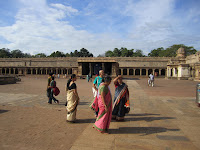Temple Festivals of Kerala epitomize royalty, grandeur and carnivals of India. And one of them is the Guruvayur Utsavam (festival) celebrated at the Guruvayur Sri Krishna Temple in Guruvayur – known as the ‘Dwaraka of the South’- in Kerala starting from 5th of March.
This March, the little town of Guruvayur will bustle with activity as it celebrates the Guruvayur Festivals – Patahadi, Dhwajadi and Ankuradi that last all month. The Temple would be richly decorated by fresh-cut flowers during day and with multi-coloured blinking lights – thousands in a row at night and the streets would be lined with flower and light decorations with spiritual music in Malayalam playing at every nook and corner. Fireworks, decorative arch-ways, bunches of coconuts and plantain trunks which are planted by most doorways is what Guruvayur experiences every March.
Remembered for the elaborate ‘pujas’ in the Guruvayur Sri Krishna Temple and the majestic Elephant parades in which Elephants adorned with ornate golden caparisons (nettipattam) parade along with hundreds of Lord Krishna devotees and the temple priests doing the drum-roll in the festival procession around the temples, the Guruvayur Festivals in March are dedicated to Lord Krishna and are much-awaited by the locals and tourists. During this month the Temple hosts several cultural programs daily. It is a feast to the eyes and the experience takes you to a whole new level of spirituality even if you’re not a Hindu.
Known to have more than 60 captive Elephants which are an integral part of the Temple Pujas & Processions, the Guruvayur Sri Krishna Temple Board has constructed an exclusive, one-of-its-kind Elephant Palace to house these regal beings of which Gajarajan Guruvayur Kesavan is the most popular and celebrated elephant for his devout behaviour. Beside pilgrimage people from all over the country visit Guruvayur Temple during this festival because of the unique Elephant Race (Aanayottam) which marks the commencement of the festival where all the elephants along with their respective mahouts race against one another on the streets of Guruvayur.
Besides partaking in the celebration of the Guruvayur Festival, rheumatic patients also pay homage to the temple’s residing deity – Lord Krishna as it is a strong belief that doing so would relieve them of their suffering and ailments.


























